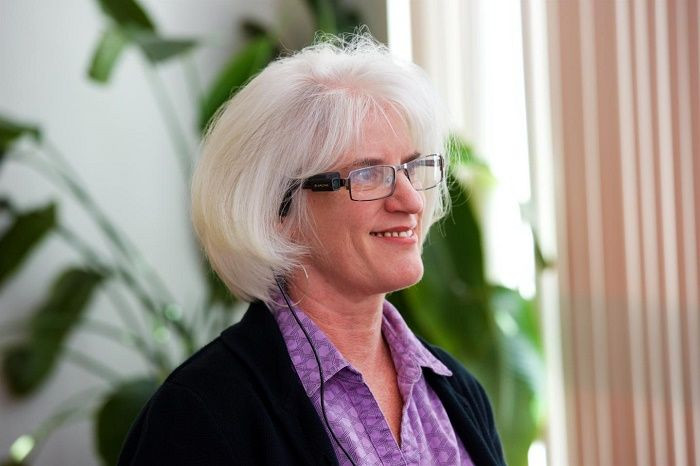New Vision Device, OrCam, Helps Improve Reading Skills In The Legally Blind

An estimated 246 million people around the world have low vision, or a form of visual impairment that cannot be corrected with surgery, pharmaceuticals, glasses or contact lenses, according to the World Health Organization. However, a new portable device may offer the visually impaired some hope.
Researchers from the University of California Davis Health System found that OrCam, a mini camera using optical character-recognition technology, can dramatically improve legally blind patient’s ability to read an email, newspaper article, menu or book. This device, which is mounted onto eyeglasses as seen in the picture above, also improves their quality of life, which allows them to better perform their daily activities.
Here's how it work: Patients read text and an earpiece that transmits sound reads it back to them. Researchers said patients could also program the device to recognize faces and commercial products.
"This device offers hope to patients who are beyond medical or surgical therapy for the condition,” researcher Mark J. Mannis said in a statement. "It is easily used and could potentially bring greater independence, particularly for older patients who are struggling with vision loss."
Those who could benefit from this device also include the large and growing number of individuals suffering from age-related macular degeneration or advanced-stage glaucoma, two of the leading causes of vision loss among the elderly in the U.S. More than 1.6 million Americans aged 50 and older have age-related macular degeneration, according to the Centers for Disease Control and Prevention, making it the leading cause of permanent visual impairment of reading and fine or close-up vision among people 65 and older. Researchers said this number is estimated to reach three million by 2020.
"Patients with low vision often are often dependent on hand-held or electronic magnifiers, which may be somewhat cumbersome to use," Elad Moisseiev, co-author and UC Davis vitreoretinal surgery fellow, said in a statement. "This is the first independent clinical study to evaluate this new low-vision-aid device based on novel optical-character recognition technology."
For the study, published in JAMA Ophthalmology, researchers recruited 12 people with low vision. All of the participants were patients at the UC Davis Eye Center at UC Davis Health System in Sacramento, Calif., and vision was 20/200 or worse in their better eye. With an average age of 62, the participants experienced vision loss from a wide array of disorders, including age-related macular degeneration and end-stage glaucoma. All were considered legally blind.
At the start of the study, none of the participants were able to perform five of the 10 tasks on the test: reading a message on an electronic device such as a smartphone or tablet, a newspaper article, menu, letter or page from a book; 11 could recognize paper money denominations; eight could locate a room in a hallway using wall-mounted signs; and seven could recognize products and distinguish between similarly shaped and sized cereal boxes.
However, after using the device for one week, the participants were able to perform nine of the 10 tasks, with only one individual having technical difficulty. They devices also appear to be easy and simple to use, with many participants vouching for its user-friendliness.
"Our results show that it can be a very useful aid for patients with low vision in performing activities of daily living, and increase their functional independence," Moisseiev said.
To confirm their results, researchers also performed a separate sub-analysis of seven patients who were using other low-vision aids and found that their performance on the test was better when using the device as well. Exciting findings, but more research is needed in order to determine the usefulness of this device among individuals with low vision.
Source: Moisseiev E, Mannis M. Evaluation of a Portable Artificial Vision Device Among Patients With Low Vision. JAMA Ophthalmology. 2016.



























